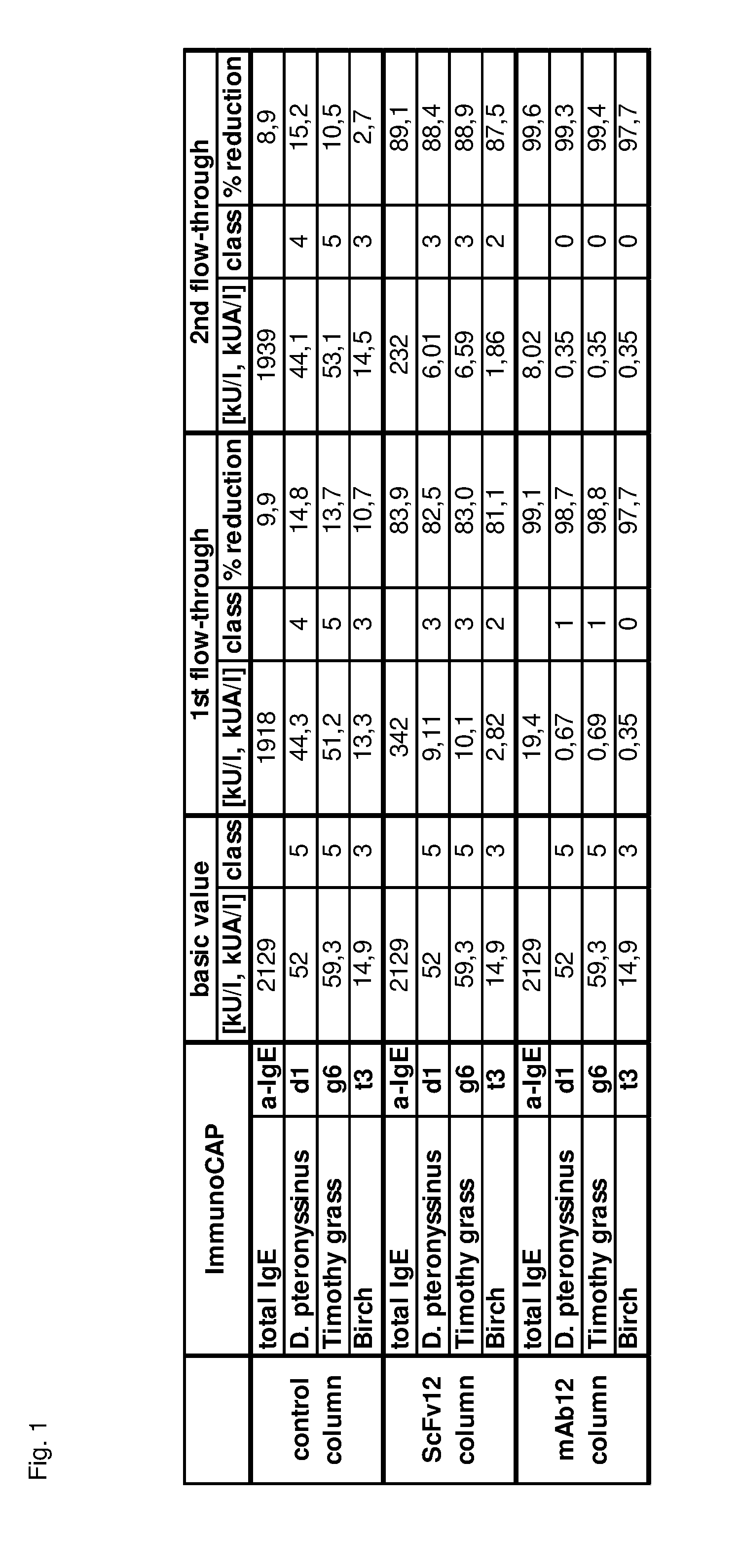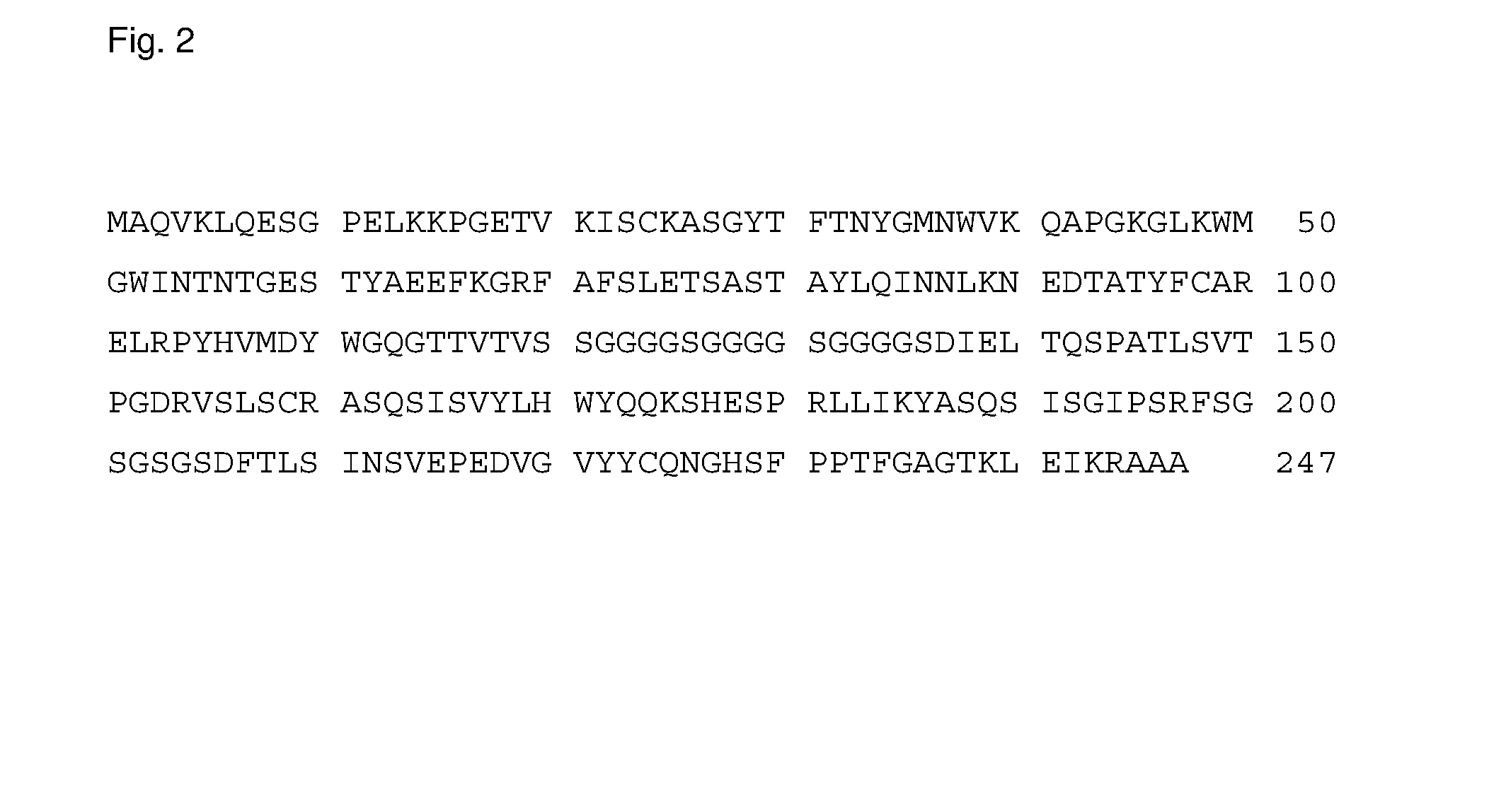IMMUNOAFFINITY SEPARATION MATERIALS COMPRISING ANTI-IgE ANTIBODY DERIVATIVES
a technology of immunoaffinity separation and anti-ige antibody, which is applied in the direction of separation process, drug composition, immunological disorders, etc., can solve the problems of severe side effects, limited therapy using these approaches, and unwanted side effects
- Summary
- Abstract
- Description
- Claims
- Application Information
AI Technical Summary
Benefits of technology
Problems solved by technology
Method used
Image
Examples
example 1
Manufacturing Process for scFv Exhibiting Specificity for Soluble and Cell Bound IgE (Anti-IgE-scFv)
[0079]Anti-IgE-scFv is manufactured by applying the following manufacturing process: The DNA sequence coding for anti-IgE-scFv was cloned into an expression vector (e.g. pET28b) and the resulting expression plasmid was transformed into competent cells of Escherichia coli BL21(DE3). Plasmid-carrying clones were selected and cultured in a culture medium containing glucose, mineral salts and trace elements by using a bioreactor (fermenter). A high cell density fed-batch cultivation procedure was applied by using a glucose-limited exponential feeding procedure. At an optical density of OD600=40-50, the recombinant expression of anti-IgE-scFv was initiated (induced) by the bolus addition of IPTG. After five hours of induced phase, the fermentation was terminated and the biomass (bacterial cells) containing the anti-IgE scFv was harvested by centrifugation. The bacterial cells were homogeni...
example 2
Preparation of Inclusion Bodies
1. High Pressure Homogenization.
[0080]Frozen biomass (−20° C.) was resuspended in a resuspension buffer containing 20 mM TrisHCl and 1 mM EDTA at pH=8.0 (250 g biomass per litre buffer). Cell suspension was thawed at room temperature under mechanical agitation for 30 min. Remaining frozen biomass was resuspended using an agitation device (Ultra-Turrax) for 1 min at about 15,000 rpm. Thawed cell suspension was subjected to a high pressure homogenizer (GEA, Panda 1K-NS1001L) for three passages at 750 bar. During homogenization, the homogenate was cooled down to 15° C. by using a heat exchanger. The crude cell homogenate was subjected to a centrifugation step at 7,000 rpm (5,500 g) and 4° C. for 60 min. The inclusion body pellets were collected and subjected to the following wash procedure.
2. Inclusion Body Washing with Triton:
[0081]Inclusion bodies containing anti-IgE-scFv were resuspended at a concentration of 60-75 g per liter of Triton washing buffer ...
example 3
Refolding Process for Anti-IgE-scFv by Applying Step-Wise Dialysis
1. Solubilization of Inclusion Bodies and Reduction of Disulfide Bonds:
[0083]Washed inclusion bodies were solubilized in a solubilization buffer (0.5-1.0 g inclusion bodies per L). The solubilization buffer contained 6 M guanidine-hydrochloride (GuHCl), 50 mM Tris-HCl, 200 mM NaCl and 1 mM EDTA at pH=8.0. The inclusion bodies were solubilized by agitation at room temperature for the time period of at least 30 min. After solubilization, the reducing agent 2-mercaptoethanol was added (10 mM final concentration), thereby reducing the disulfide bonds of the anti-IgE-scFv. This solution was agitated at room temperature for at least 30 min.
2. Step-Wise Dialysis (Refolding Step):
[0084]The 2-mercaptoethanol was removed by dialysis (membrane cut-off 10 kDa) against the same solubilization buffer as described above (at 4° C. for 15 h).
[0085]GuHCl was removed by applying a number of serial dialysis steps (dilution factor 40-60) ...
PUM
| Property | Measurement | Unit |
|---|---|---|
| molecular weight | aaaaa | aaaaa |
| time | aaaaa | aaaaa |
| molecular mass | aaaaa | aaaaa |
Abstract
Description
Claims
Application Information
 Login to View More
Login to View More - R&D
- Intellectual Property
- Life Sciences
- Materials
- Tech Scout
- Unparalleled Data Quality
- Higher Quality Content
- 60% Fewer Hallucinations
Browse by: Latest US Patents, China's latest patents, Technical Efficacy Thesaurus, Application Domain, Technology Topic, Popular Technical Reports.
© 2025 PatSnap. All rights reserved.Legal|Privacy policy|Modern Slavery Act Transparency Statement|Sitemap|About US| Contact US: help@patsnap.com


